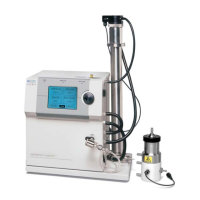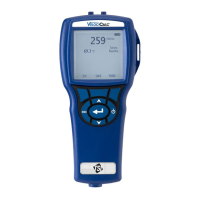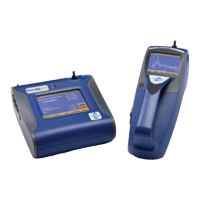Operating SMPS™ Hardware 4-5
Impactor as a Flowmeter
The primary function of the impactor is to remove larger particles
that carry more than a single charge (see Appendix B
). However, the
impactor is also used as a flowmeter, since the pressure drop
across the impactor is proportional to the square of the flow rate.
Ideally, the cut size of the impactor would match the upper size
limit of the measurement range. However, due to pressure drop
constraints, this is not possible in many cases. When the impactor
cut is not at or below the upper measured particle size limit, care
must be taken interpreting the data. This is particularly true if
there are a large number of particles with a size near or above the
upper measurement limit. Particles larger than the upper size limit
may carry multiple charges and will cause over counting in the
upper size channels.
You can use three different orifices with the impactor: 0.0457 cm,
0.0508 cm, and 0.071 cm diameter. Table 4-2 gives the impactor
cut point as a function of flow rate for the two smaller orifices. The
0.071 cm impactor is considered to have a practical cut point above
1000 nm (the upper limit of the SMPS
™ spectrometer) and,
therefore, is not included in the table.
As can be seen from the values in Table 4-2, the orifice size and
flow rate determine the largest particle size that can be sampled
within each SMPS
™ spectrometer measuring size range.
Note
The pressure drop information in Table 4-2 is approximate and should
not be substituted for the impactor curve information provided with
each SMPS
™ spectrometer.
Table 4-2
Impactor ∆P and 50% Cut Size vs. Flow Rate
Polydisperse
Aerosol
0.0457 cm Orifice
0.0508 cm Orifice
Flow rate
(L/min)
P*
(cm H
2
O)
50% Cut
(
m)
P*
(cm H
2
O)
50% Cut
(
m)
0.2
0.25
0.3
0.4
0.5
0.6
0.7
1.0
2.50
3.94
5.66
10.1
15.8
22.7
30.9
61.2
0.846
0.748
0.677
0.576
0.508
0.457
0.418
0.338
1.90
2.56
3.71
6.58
10.3
14.8
20.1
40.0
1.006
0.892
0.808
0.690
0.609
0.550
0.503
0.409
*Actual pressure drop is usually greater than predicted due to surface roughness
and imperfections in the nozzle.
